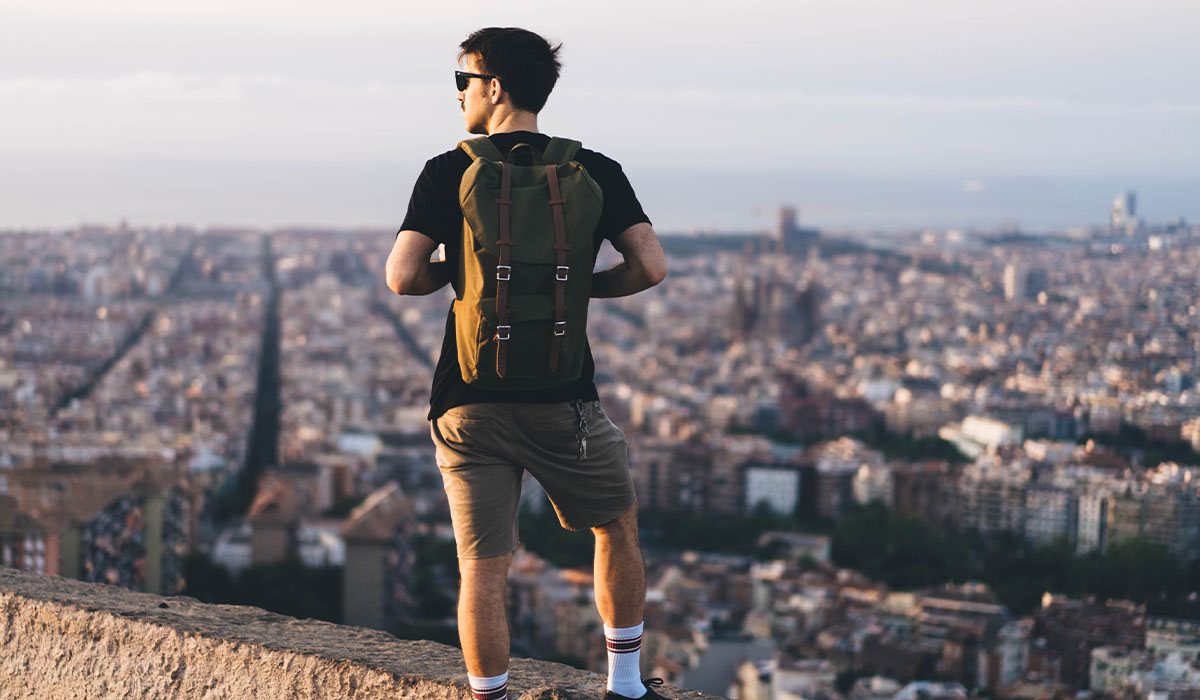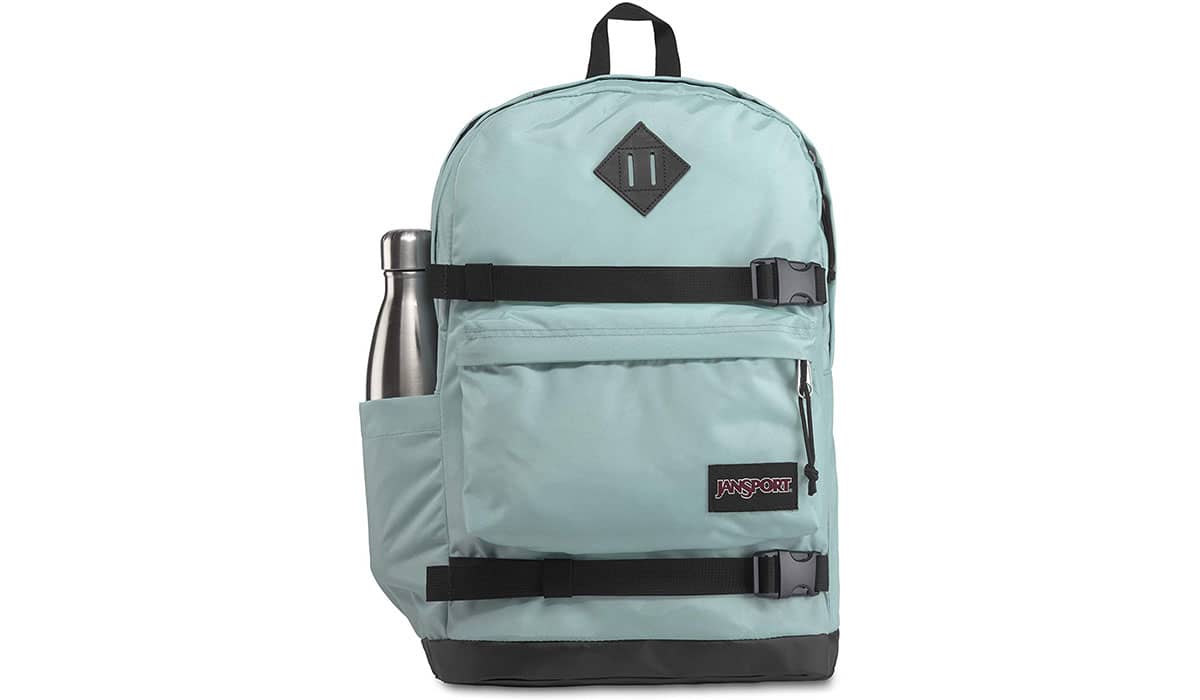
+
–
Table of Contents
1. Marmot Colma – Editor’s Pick
Perhaps the most versatile pack on the list, the Colma from Marmot will be just as at home on a 10-mile hike as it will getting your laptop to work on the train. Marmot is one of the premier names in pack design, so you don’t have to worry about the little things not being right, they’ve already worked that out.
The laptop pocket fits devices up to 15” and has a side access, so you reach your computer easier in crowded or limited-access situations. The front of the pack features dual zippered pockets for keeping smaller or less-used items organized. The electronics pocket is fleece lined to keep screens and finishes in perfect condition. It’s just an all-around pack that is going to perform in the urban or literal jungle.
Pros/ Tech features that make it perfect for everyday use
Cons/Not hydration compatible for long hikes
Bottom Line/A great backpack option for the trails or the trains
2. Jansport West Break – Budget Pick
Jansport has been making affordable, quality packs for a long time, and the West Break is just another example of that. It’s a straightforward pack design, but the 600 denier TPU bottom will hold up to the abuses of everyday use. An internal sleeve accepts laptops up to 15” and helps keep things organized. Two main compartments give you flexibility to load it up with just about anything, and organize it the way that makes sense for you. The top stash pocket is perfect for those things you need to be able to reach quickly. It’s a simple design, but it’s a design that has served us for a long time, and there’s no reason the West Break won’t do the same.
Pros/Reliable product from a reliable company
Cons/None of the high-end flash of some of the other options
Bottom Line/Most of us aren’t maxing out what our gear can do, no need to get more pack than you need
3. Vertx Gamut 2.0 – Double-Duty Pick
A backpack might be part of your EDC (every day carry) but a lot of other things might be as well. Things like a computer, first aid kit, maybe even a defensive handgun. Carrying concealed can be a tricky situation with some forms of work attire, and the last thing you want to do is draw attention to yourself. Luckily, the same innovative design features that can be used to protect electronics, can also offer a great carrying solution for your EDC handgun.
The Vertx Gamut employs a print-proof scabbard that is perfect for protecting electronics, and for giving you a location to carry a handgun that is all but undetectable. That’s just as usual in the backcountry as it is on main street. The Gamut 2.0 is a great choice for those who carry, but even if you don’t the rigid scabbard offers a level of protection for your other items that no soft pack can offer.
Pros/Ultra-secure backpack option
Cons/Protection comes at a cost – It’s pricey
Bottom Line/ If you want a pack that lets you carry (anything) without looking like a commando, this is the way to go
4. Osprey Skarab 30 – Off-Road Pick
A rucksack design gets a modern spin from Osprey. The voluminous 30L capacity is handy for long days at the office or in the backcountry. Also handy is the AirScape suspension that offers more comfort and ventilation than other suspension systems. The rucksack design means you don’t have a bunch of small pockets to remember and organize, you just load up and go. Maybe you need some smaller packs inside for things like first aid or snacks, just to make them easier to find, but when you need a change of clothes, rain gear, or multiple devices for what the day brings, you’ll appreciate the wide-mouth open design of the pack.
Pros/Hydration compatible for long days in the bush
Cons/If you’re a neat freak, the rucksack design might not be for you
Bottom Line/Super-capable pack design that will get you there and back no matter where you’re going
Determining backpack size needs
As you may have noticed, there are a lot of different sizes of backpacks on the market. If you buy one that’s too big, it’ll may affect the fit and be uncomfortable. If you buy one that’s too small, that creates a whole series of issues, too.
How do you determine what size backpack you need? Only you can answer that, but for daily usage anything between 1000-2000 cubic inches should serve you fine. A lot of it comes down to personal preference. Some people want a pack where everything has a home and is very organized. A waste not want not mentality. Others would rather have the extra space for a just-in-case situation. Do your homework, lay out what you plan to need to carry, and find the pack that will let you do it how you want.

What to carry everyday
Obviously, you need to be able to carry the things you need every day. This might mean your computer or other devices, backup power supply, a change of clothes, snacks, water, or first aid kit. No two days look the same from person to person, so it’s really up to you, but for me, I like having a little peace of mind knowing I can handle a power outage or small accident so backup power supplies and first aid spring to the top of the list. A knife is a good call, too, just remember it’s there in case you go somewhere they aren’t allowed. And whatever you do, make sure you take it out before you go to the airport.
What should I look for in a backpack?
The biggest considerations when picking out a backpack are:
- Use – Know what you want it for and how you need it to work
- Cost – Don’t overpay for features you don’t intend to ever use
- Materials – Make sure you’re buying quality and not something that will not work with your lifestyle
- Comfort – Be sure it has ample padding for you in the shoulders and back
- Protection – If you’re carrying your laptop, it needs to offer good protection
Are backpacks considered unprofessional?
It used to be that if an executive walked in with a backpack, it was, shall we say, frowned upon. That is definitely not the case anymore. You’ll find many CEO these days using a backpack simply because it is the easiest and best way to carry a bunch of stuff and still have use of your hands.
How will I know if my laptop fits in a backpack?
Most backpacks that have a sleeve dedicated to carry a laptop will have the dimensions listed somewhere as to how big of a laptop it will carry safely.You can always carry a smaller laptop than your backpack will carry, but if you run out of room, you may have issues. Most modern backpacks will carry a 15-inch laptop, and many will fit a 17-inch. If you’re laptop is bigger than that, you should be very careful about what you buy.
We are committed to finding, researching, and recommending the best products. We earn commissions from purchases you make using the retail links in our product reviews. Learn more about how this works.




